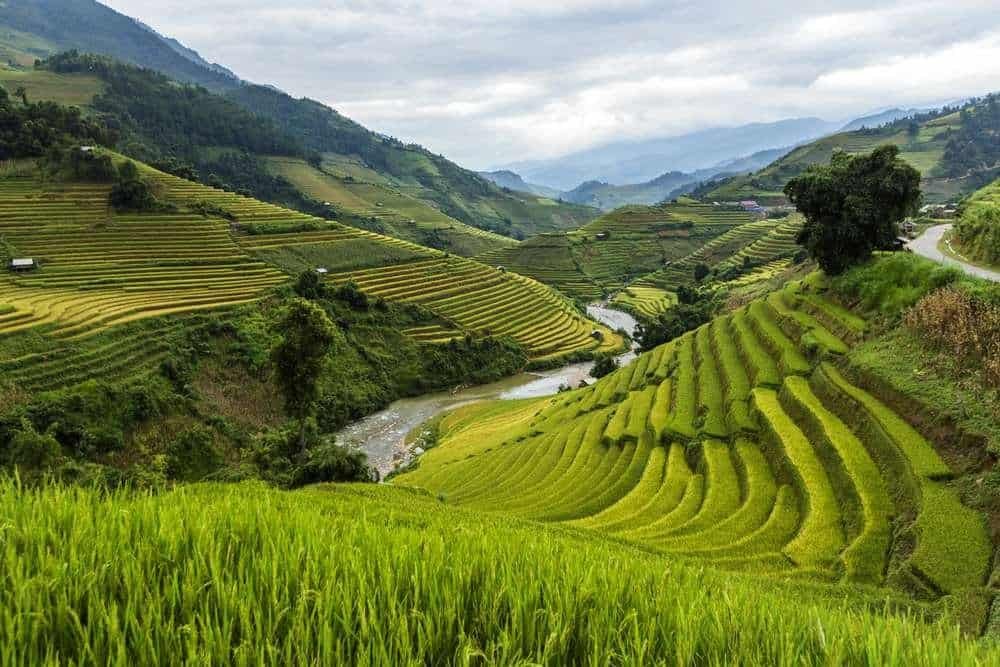tl;dr: Terracing is used in Southeast Asian agriculture for several reasons
Terracing is a common agricultural practice in Southeast Asia that serves multiple purposes. It helps prevent soil erosion, maximizes land use, manages water resources, improves crop yields, and preserves traditional farming practices. By implementing terracing techniques, farmers in this region can overcome the challenges posed by hilly terrain and create sustainable and productive agricultural systems.
Preventing soil erosion
One of the primary reasons terracing is used in Southeast Asian agriculture is to prevent soil erosion. The hilly landscapes in this region are prone to heavy rainfall, which can wash away the topsoil and nutrients essential for plant growth. By constructing terraces, farmers create level platforms on the slopes, which act as barriers to slow down the flow of water. This helps to retain the soil and prevent erosion, ensuring the fertility of the land is preserved for future cultivation.
Maximizing land use
Terracing allows farmers to maximize land use in areas with steep slopes that would otherwise be unsuitable for cultivation. By creating flat or gently sloping terraces, farmers can transform previously unusable land into productive agricultural spaces. This enables them to expand their farming activities and increase food production to meet the growing demands of the population.
Managing water resources
Water management is crucial in Southeast Asian agriculture, where monsoon rains can be intense and unpredictable. Terracing helps farmers effectively manage water resources by preventing excessive runoff and promoting water infiltration. The terraces act as mini-reservoirs, allowing water to be retained and gradually released, ensuring a steady supply for crops throughout the year. This helps to mitigate the risk of droughts and floods, providing a more stable environment for agriculture.
Improving crop yields
Terracing plays a vital role in improving crop yields in Southeast Asian agriculture. The level platforms created by terraces provide a more even distribution of water and nutrients to the crops. This promotes healthier plant growth and reduces the risk of waterlogging or nutrient leaching. Additionally, terracing helps to control soil erosion, which can lead to the loss of valuable topsoil and negatively impact crop productivity. By implementing terracing techniques, farmers can optimize growing conditions and achieve higher yields.
Preserving traditional farming practices
Terracing has been used in Southeast Asian agriculture for centuries and is deeply rooted in traditional farming practices. By continuing to employ terracing techniques, farmers in this region preserve their cultural heritage and maintain a connection to their ancestors. These traditional methods have proven to be effective in adapting to the challenging terrain and climate of Southeast Asia, making them an integral part of the agricultural landscape.
Conclusion
Terracing is a fundamental practice in Southeast Asian agriculture, serving multiple purposes that contribute to sustainable and productive farming systems. By preventing soil erosion, maximizing land use, managing water resources, improving crop yields, and preserving traditional farming practices, terracing enables farmers to overcome the challenges posed by hilly terrains and create thriving agricultural communities. Embracing terracing techniques not only ensures food security but also helps to maintain the rich cultural heritage of Southeast Asian farming.
FAQs
Why is terrace farming used in Asia?
Terrace farming is used in Asia because it allows farmers to cultivate steep slopes and hilly terrains, maximizing the use of available land for agriculture. It helps prevent soil erosion, conserves water, and provides better control over irrigation.
Why did terrace farming become so popular in Southeast Asia?
Terrace farming became popular in Southeast Asia due to the region’s mountainous terrain and heavy rainfall. It enabled farmers to create flat surfaces on slopes, preventing soil erosion and ensuring efficient water drainage. Additionally, terrace farming allowed for the cultivation of rice, a staple crop in the region.
Why is terracing used in southeast asian agriculture?
Terracing is used in Southeast Asian agriculture to overcome the challenges posed by the region’s rugged topography. It helps create level surfaces for farming, prevents soil erosion, and facilitates efficient water management. Terracing also allows for the cultivation of crops that require specific water conditions, such as rice.
What is the terraced farming technique? Why is it useful?
Terraced farming is a technique where sloping land is transformed into a series of flat, horizontal platforms or terraces. These terraces are built with retaining walls to prevent soil erosion and provide level surfaces for cultivation. It is useful because it maximizes the use of available land, prevents soil degradation, conserves water, and allows for the cultivation of crops in challenging terrains.
Originally posted 2023-08-31 07:08:36.


